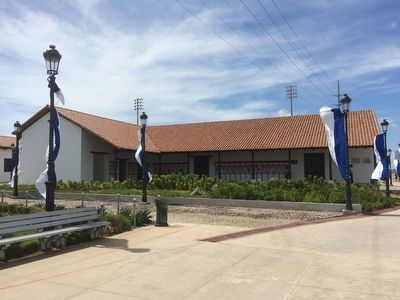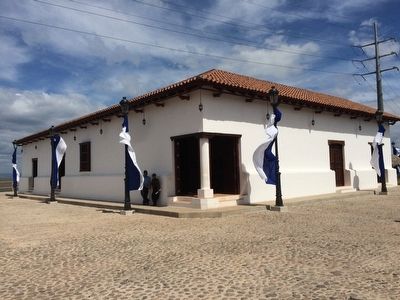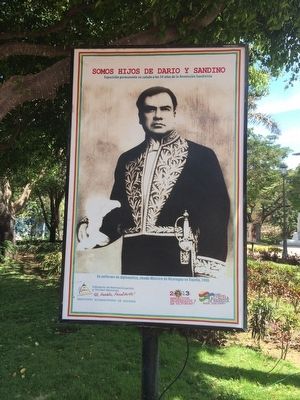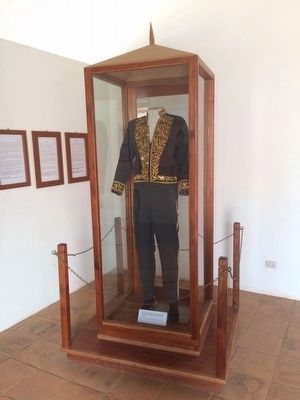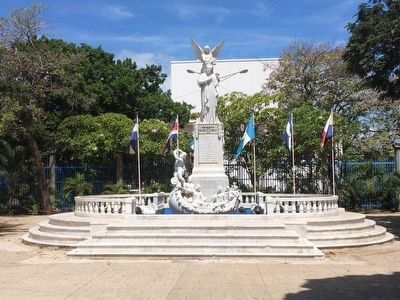Managua , Nicaragua — Central America
Rubén Darío's Home
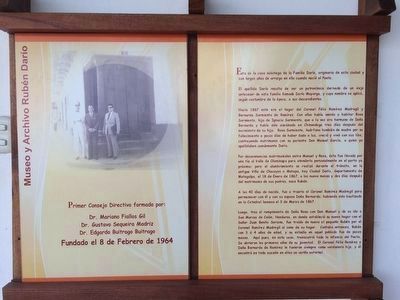
Photographed By J. Makali Bruton, February 13, 2016
1. Rubén Darío's Home Marker
Caption: Museo y Archivo Rubén Darío, Primer Consejo Directivo formado por: Dr. Mariano Fiallos Gil, Dr. Gustavo Sequeira Madriz, Dr. Edgardo Buitrago Buitrago. Fundado el 8 de Febrero de 1964
(English: Museum and Archive Rubén Darío, First Board of Directors formed by: Directors names, Founded February 8, 1964)
(English: Museum and Archive Rubén Darío, First Board of Directors formed by: Directors names, Founded February 8, 1964)
Esta es la casa solariega de la Familia Darío, originaria de esta ciudad y con largos años de arraigo en ella cuando nació el Poeta.
El apellido Darío resulta de ser un patronímico de un Viejo antecesor de esta familia llamado Darío Mayorga, y cuyo nombre se aplicó, según costumbre de la época, a sus descendientes.
Hacia 1867 este era el hogar del Colonel Félix Ramírez Madregil y Bernarda Sarmiento de Ramírez. Con ellos había venido a habitar Rosa Sarmiento, hija de Ignacio Sarmiento, que a la vez era hermano de Doña Bernarda y había sido asesinado en Chinandega tres días después del nacimiento de su hija. Rosa Sarmiento, huérfana también de madre por su fallecimiento a pocos días de haber dado a luz, creció y vivió con sus tíos; contrayendo matrimonio con su pariente Don Manuel García, a quien ya apellidaban comúnmente Darío.
Por desavenencias matrimoniales entre Manuel y Rosa, ésta fue llevada por una tía al Valle de Olminapa para atenderla personalmente en el parto ya próximo; pero el alumbramiento se realizó durante el tránsito, en la antigua Villa de Chocoyos o Metapa, hoy Ciudad Darío, departamento de Matagalpa, el 18 de Enero de 1867, a los nueve meses y dos días después del matrimonio de sus padres, nace Rubén.
A los 40 días de nacido, fue a traerlo el Coronel Ramírez Madregil para permanecer con él y con su esposa Doña Bernarda; habiendo sido bautizado en la Catedral leonesa el 3 de Marzo de 1867.
Luego, tras el rompimiento de Doña Rosa con Don Manuel y de su da a San Marcos de Colón, Honduras, en donde estableció su nuevo hogar con el Señor Juan Benito Soriano, fue traído de nuevo el pequeño Rubén por el Coronel Ramírez Madregil al seno de su hogar. Contaba entonces, Rubén con 3 ó 4 años de edad, y su estadía en aquel poblado fue de pocos meses. Aquí pues, en esta casa, transcurrió toda la infancia del Poeta. Se abrieron los primeros años de su juventud. El Coronel Félix Ramírez y Doña Bernarda de Ramírez le tuvieron siempre como verdadero hijo, y él encontró en toda ocasión en ellos un cariño paternal.
English translation:
This is the ancestral home of the Darío family, originally from this city and with long years living here when the poet was born.
The name Darío is from the name of an ancestor of this family named Darío Mayorga, whose name was applied, according to the custom of the time, to their descendants.
By 1867 this was the home of Colonel Felix Ramirez Madregil and Bernarda Sarmiento Ramirez. With them had come to dwell Rosa Sarmiento, daughter of Ignacio Sarmiento, who was the brother of Doña Bernarda and who had been killed in Chinandega three days after the birth of his daughter. Rosa Sarmiento, also motherless
after her mother’s death a few days after giving birth to Rosa, grew up and lived with her aunt and uncle; she eventually married her relative Don Manuel Garcia, who normally used the last name of Darío.
Due to marital discord between Manuel and Rosa, she was taken by an aunt to Olminapa Valley in order to deliver her baby there; but Rubén was born during the trip, in the old town of Chocoyos or Metapa, now called Ciudad Darío, in Matagalpa department, on January 18, 1867, nine months and two days after the marriage of his parents.
At 40 days old, Colonel Ramírez Madregil brought him to stay with him and his wife Doña Bernarda; he had been baptized in León Cathedral on March 3, 1867.
After Doña Rosa and Don Manuel finally broke up for good, Rosa left for San Marcos de Colón, Honduras, where she established her new home with Juan Benito Soriano. He was brought back a little later by Colonel Ruben Ramirez Madregil again to this, his home. Rubén was then 3 or 4 years old, and he had only stayed in San Marcos de Colón a few months. Here then, in this house, the Poet passed his entire childhood. The first years of his youth were spent here. Colonel Félix Ramírez and Doña Bernarda Ramírez always held him as a true son, and on every occasion he found in them true parental affection.
Topics. This historical marker is listed in this topic list: Arts, Letters, Music
. A significant historical date for this entry is January 18, 1867.
Location. 12° 9.592′ N, 86° 16.329′ W. Marker is in Managua. Marker can be reached from Paseo Xolotlán close to 14 Calle Noroeste. The marker is along the covered corridor of the Rubén Darío Archive and Home Museum. Touch for map. Marker is in this post office area: Managua 11001, Nicaragua. Touch for directions.
Other nearby markers. At least 8 other markers are within 3 kilometers of this marker, measured as the crow flies. Visits of Pope John Paul II to Nicaragua (approx. 0.3 kilometers away); Francisco Morazán (approx. 0.4 kilometers away); Tomb of Three Founders of the Sandinistas (approx. 0.4 kilometers away); Fulgencio Vega (approx. 0.4 kilometers away); Martyrs of the National Workers Front (approx. 0.6 kilometers away); Monument to the Heroes of April 4, 1954 (approx. 2 kilometers away); Dr. Pedro Joaquin Chamorro Cardenal (approx. 2 kilometers away); The Presidential House of Nicaragua (approx. 2 kilometers away). Touch for a list and map of all markers in Managua.
Regarding Rubén Darío's Home. Félix Rubén García Sarmiento, known as Rubén Darío, was a Nicaraguan poet who initiated Spanish-American modernist literary movement at the end of the nineteenth century. Darío had a great influence on 20th century Spanish literature and journalism. He has been praised as the "Prince of Castilian Letters". Darío is revered as Nicaragua's greatest
diplomat and a leading voice of Central and South America. He is one of the most celebrated Nicaraguans within the country, usually on par with Augusto Sandino.
One of his most famous poems (translated into English) is "Fatality":
The tree is happy because it is scarcely sentient;
the hard rock is happier still, it feels nothing:
there is no pain as great as being alive,
no burden heavier than that of conscious life.
To be, and to know nothing, and to lack a way,
and the dread of having been, and future terrors...
And the sure terror of being dead tomorrow,
and to suffer all through life and through the darkness,
and through what we do not know and hardly suspect...
And the flesh that tempts us with bunches of cool grapes,
and the tomb that awaits us with its funeral sprays...
Credits. This page was last revised on February 12, 2022. It was originally submitted on April 4, 2016, by J. Makali Bruton of Accra, Ghana. This page has been viewed 350 times since then and 23 times this year. Photos: 1, 2, 3, 4, 5, 6. submitted on April 5, 2016, by J. Makali Bruton of Accra, Ghana.
